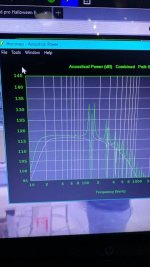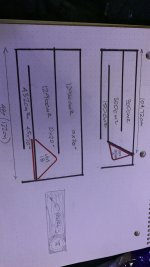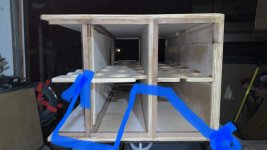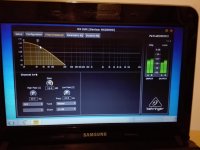I said is " booming bass " correct ? Sorry, I was in the middle of uploading attachments and I missed it. I don't agree with that either, well calculated BR cabinets are not, not at all...such an unfair answer sir!?😳
Then try listening to Bach's Toccata and Fugue and tell me how deep and low those tubes sound...Sorry, all my subs are either open baffle or sealed. Can't stand resonances involved.
Reminds me of car audio people, one note samba. Boom boom, no matter what music is on.
Car audio ? We are not talking about car audio in this thread.
Then I would not be analyzing cabinets, but a resultant...Are you adding any EQ to the sealed subs? If so add that to the simulation and recompare group delay.
I use DSP, not EQ when listening, I don't need it.
No one ?😳I have read that the group delay at frequencies this low is totally inaudible. Clearly wins sealed
Opinions ?
https://www.audioholics.com/loudspeaker-design/10-nonsense-myths
Mith 8 :
" Chasing the Truth: I call mischief. Nonsense again. If a ported subwoofer sounds boomy, it's either a poor design with a non-flat response, or it's misconfigured (which isn't inherent to ported designs). Well-designed ported subwoofers are just as tight and articulate as sealed subwoofers. In many cases, the increased tension some perceive from sealed subwoofers is simply the fact that there is less bass coming from the lower octaves in a sealed design. However, that's just a responsive issue and can be mimicked in a ported layout. While there are poorly designed ported subwoofers, there are plenty of poorly designed sealed subwoofers. This is not a point of comparison."
This is my goal, those harmonics in the first octaves......🙄
Mith 8 :
" Chasing the Truth: I call mischief. Nonsense again. If a ported subwoofer sounds boomy, it's either a poor design with a non-flat response, or it's misconfigured (which isn't inherent to ported designs). Well-designed ported subwoofers are just as tight and articulate as sealed subwoofers. In many cases, the increased tension some perceive from sealed subwoofers is simply the fact that there is less bass coming from the lower octaves in a sealed design. However, that's just a responsive issue and can be mimicked in a ported layout. While there are poorly designed ported subwoofers, there are plenty of poorly designed sealed subwoofers. This is not a point of comparison."
This is my goal, those harmonics in the first octaves......🙄
https://www.trueaudio.com/post_010.htm Personally, with the 'critically' damped speakers I've built it was a moot point once I found out what folks were talking about since I'd never been exposed to group delay per se.No one ?😳
IMO the group delay from a lot of BR subs is really audible and unpleasant. When you're talking about a difference of 20+ms, the idea that that's "not audible" is very questionable to me.
AFAIK the tradeoff is you get like +3dB bass in exchange for more group delay and possible port maladies. IMO 3dB ain't worth it, just buy bigger amps. 😀
AFAIK the tradeoff is you get like +3dB bass in exchange for more group delay and possible port maladies. IMO 3dB ain't worth it, just buy bigger amps. 😀
What about ‘TL’ or TL hybrid? Surely you can tell the difference and then many of us often agree about what you probably dislike in the ported box from the generic standpoint (port noise or similar) because there are issues if we are being honest/fair … and car audio isn’t ever going to win. An argument is so you got that one every time😆👍🏼Sorry, all my subs are either open baffle or sealed. Can't stand resonances involved.
Reminds me of car audio people, one note samba. Boom boom, no matter what music is on.
The biggest difference might be is looking at what GM refers to, with the toggle switch and critical damping to our ear. This is like night and day. It’s also some of the best advice I’ve ever read anywhere and fixes so many issues for just about anything I’ve ever looked at in this way(outstanding in many of these obnoxious higher order cabinets that desperately need some of this more than not)
Last edited:
Sealed 360 liters x 120cm , with eq and filter to protect, or MLTL of the same (dayton umax18 for a random example ) at ~120/120/120 (offset entry 2fold)…. I’ll just seal it up , if sealed is so good? since it’s so easy to do in this case. ??? Hard to argue when everyone’s right. I just stole the blueprints from Nikola Tesla, and the device to use to cure Mark Twain’s constipation.I said is " booming bass " correct ? Sorry, I was in the middle of uploading attachments and I missed it. I don't agree with that either, well calculated BR cabinets are not, not at all...
Attachments
Last edited:
That should have been a Bose advertising strapline...Boom boom, no matter what music is on.
Make no mistake, a ported enclosure is a poorly damped resonator which stores energy, and the bigger they are the longer they ring after the signal has ceased, which can be 1/4 second or more...... see what would happen if I converted my two sealed subwoofers (which I built and documented here at Diy Audio ) to bass reflex ...
If you can live with this 'smearing' of transient events and need to achieve higher output then porting your enclosures will achieve this gain.
Stored or damped out and thus resolved ? Which one is the truth ? There’s some fine tuning involved or there’s just fanboy comments of the diy sealed subwoofer peeps who trash these threads with unfair bias everytime (not that there’s anything wrong with sealed subwoofers in any way first and foremost if not too small and weak/neutered since “truth” was mentioned, honest/fair/real/independent of what’s in you living room, flies too as it does )🙏🏻😀Make no mistake, a ported enclosure is a poorly damped resonator which stores energy, and the bigger they are the longer they ring after the signal has ceased, which can be 1/4 second or more...
If you can live with this 'smearing' of transient events and need to achieve higher output then porting your enclosures will achieve this gain.
you can’t get blood from a turnup and you can’t squeeze a fart out of a sealed box either. But I’ll be darn if an 3 section, 2 fold air column isn’t a beautiful thing for any transducer that needs to be in there exciting it just right (not stinky base reflex farts)
Last edited:
Both, clearly, as I'm sure you well understand. Energy provided by the driver is stored in the Helmholtz resonator and damping dissipates the energy as heat. Any form of horn loading also stores energy, the larger of which have even longer delay times.Stored or damped out and thus resolved ? Which one is the truth ?
I trust you don't include me as a fanboy trasher - I'm simply quoting known facts to help the OP weigh the options... We all know the woeful LF efficiency of sealed enclosures and the poor step response of most other loadings; compromise, compromise, but where?
ANY type of processing adds delay and phase shift and if the speaker design can't be used without it has to be considered part of the design.Then I would not be analyzing cabinets, but a resultant...
I use DSP, not EQ when listening, I don't need it.
The question posed in the title of this thread is what is gained/lost, in general a ported sub removes the need for the low freq EQ boost that sealed subs require so IMO this fits perfectly here.
It seems that it would not be worth going ahead with the graphics, if such a simple question does not have some scientific answer.No one ?😳
I don't think anyone has seen that if you enlarge the attachments of post 16, in them you can see - top right, red arrow! - the respective group delays of MY box and my speaker :
For a 20 Hz sine wave,
Vented is 14,906 Ms. and Sealed is 4,074 Ms.
Those almost 15 ms. in the BR are inaudible to me and the bibliography confirms it.
When I was using my AVR for HT I did a lot of rehearsals with different delays and in MY room I really couldn't tell any difference.
I will answer the threads that deserve my attention from what has been posted up to here, and I will let those who want to elaborate on their preferences on whether Sealed or Vented continue. That was not the idea, by the way, I thought I could attach here the exchange emails with Jerry McNutt from Eminence, but it will not be worth the effort. It seems that those who say they know a lot don't bother to comment, and those who repeat basic things already known abound and everything is distorted...
And since I am a respectful person and I want to respond to everyone, moving on becomes very difficult.
So "radio silence" for some posts.
I will look for another activity to keep my mind active, although on second thought, chess is much better than this. Especially when I manage to give "Mate" in a few plays.
Thanks GM for the attachment. But I don't think a 10 ms difference in the first two octaves would be audible, at least not to me. And maybe yes, and that's the delay I'm looking for ! . 🤔https://www.trueaudio.com/post_010.htm Personally, with the 'critically' damped speakers I've built it was a moot point once I found out what folks were talking about since I'd never been exposed to group delay per se.
You have opened Netflix to watch movies, I imagine. Well, on my vintage JBL 14-inch 80-litres in BR, that series-opening "shock" sounds much nicer to my ears than on the Eminence sub, fed from another amp of course. ( and not filters )
" But real speakers don't add seconds of delay. They only add milliseconds or tens of milliseconds of delay. So the real question comes down to "how much delay is just audible". If we were to gradually reduce the delay in the above experiment to zero there would come a point where the delay was no longer audible as a separate distinct sound. This would probably happen above the Hass limit of 30ms or so. As the delay is reduced further there would come a point where the "delay distorted" or "time smeared" version was indistinguishable from the original recording. This delay would represent the threshold of audibility for this delay curve and source material." 🙂
Last edited:
I use 450 Watts / channel only to power the zone that you can see in the attachment.IMO the group delay from a lot of BR subs is really audible and unpleasant. When you're talking about a difference of 20+ms, the idea that that's "not audible" is very questionable to me.
AFAIK the tradeoff is you get like +3dB bass in exchange for more group delay and possible port maladies. IMO 3dB ain't worth it, just buy bigger amps. 😀
I am very happy with the sound achieved and I do not deny my sealed sub's, I only had a concern, "what would happen if...."
"Curiosity kills at man" 😏
Attachments
Last edited:
I sense a little blurring in the comments conflating system energy storage and group delay. They are different flaws and both may - or may not - be audible to any particular listener in any great degree.
Just like women, food, music and cars we all have different tastes!
Just like women, food, music and cars we all have different tastes!
Hmm, "blurring", ha. That's a good point though.I sense a little blurring in the comments conflating system energy storage and group delay. They are different flaws and both may - or may not - be audible to any particular listener in any great degree.
Just like women, food, music and cars we all have different tastes!
In a group delay plot, would stored BR energy show up as GD, or is it only visible in a CSD plot?
Either way, I can't stand when the bass is late OR overstays its welcome. So I definitely lean sealed even if it's somewhat futile in my room.
Not surprising, when you consider what a room can do to the response of a loudspeaker in low frequencies. Those who think that they can hear the audibility of a few ms of GD in a room with all those room modes at low frequencies are living in serious la-la land. Maybe out in an open field they might hear the difference, but in a living room? I doubt it.When I was using my AVR for HT I did a lot of rehearsals with different delays and in MY room I really couldn't tell any difference.
The best bass I've ever heard in-room were from "vented" speakers. One was an EBS subwoofer that I built many years ago, and my current favourite is an offset-TL that's basically a vented alignment with a long "vent".
- Home
- Loudspeakers
- Subwoofers
- Sealed subwoofer to bass reflex, what do I gain and what do I lose ?



